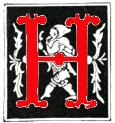
enry Stacy Marks was born at 92 Great Portland Street, London, on 13 September 1829, the fourth child of Isaac Daniels Marks and Elizabeth Pally. His father was a solicitor who later became a coachbuilder. Henry's initial education was in small schools in Regent's Park and later at Eythorne in Kent. In 1845 he worked for a time as a clerk in a warehouse belonging to a friend of his father, but then later with his father at Marks & Co., Coachmakers, in Langham Place, London. Henry showed little aptitude for commercial business. but had been fond of drawing from his childhood. In 1847 he began attending evening life classes at James Matthews Leigh's Academy in Newman Street, where he became friends with fellow students Fred Walker, Philip Calderon, and G. A. Storey. In December 1851 he was successful in being accepted into the Royal Academy Schools, but never passed into the Life Class and failed to win any medals.

Sketch of Henry Stacy Marks, by Hubert von Herkomer (Marks 1:) 146
In 1852 he moved to Paris with his friend Philip Calderon to study at the atelier of François-Édouard Picot and also at the École des Beaux-Arts. After five months he returned to London in June of that same year. Henry first exhibited at the Royal Academy in 1853 and continued to exhibit there until 1897. He also exhibited at the British Institution, the Dudley Gallery, the Society of Painters in Water Colours, the Society of British Artists, and the Fine Art Society. His early works from the 1850s and 1860s primarily featured medieval scenes based on Shakespeare. In October 1856 he married Helen Drysdale.
Marks supplemented his income from painting by doing illustrations for books and magazines, particularly the periodical The Home Circle, and by carrying out decorative works for firms like the porcelain maker Mintons. He also designed stained-glass windows, and practiced as a glass painter for the firm of Clayton and Bell. He designed part of the external frieze, illustrative of the arts and manufactures, which runs around the Albert Hall. His contribution included personifications of Astronomy, Agriculture, Horticulture, and Surveying. Amongst his other decorative commissions was designing the proscenium both for the Gaiety Theatre, London, and the Prince's Theatre, Manchester. He was also employed in the painting of furniture and was one of the artists involved with decorating William Burges' Great Bookcase.
In 1860 he travelled to Belgium with his early patron Charles Edward Mudie and in 1863 he repeated the visit with his friends W. F. Yeames and J. Hodgson. Marks's most important patron, however, became Hugh Lupus Grosvenor, the first Duke of Westminster, for whom he carried out decorative schemes for Eaton Hall between 1874 and 1880. His first commission was for a frieze representing the Canterbury Pilgrims that occupied two walls of a large saloon. Marks was to later execute similar decorative work for Stewart Hodgson's houses in South Audley Street, London, and Lythe Hill, Haslemere.
In 1862 Marks moved from Camden Town to Hamilton Terrace in St. John's Wood and became a founding member of the St. John's Wood Clique, which also included P. H. Calderon, G. D. Leslie, G. A. Storey, D. W. Wynfield, and W. F. Yeames. In 1871 he was elected as an Associate of the Society of Painters in Water Colours and became a full member in 1883. He was made an Associate of the Royal Academy in 1871 and a Full Member in 1878.
After the death of his first wife in 1892, the following year he married Mary Harriet Kempe, who was also a painter. Marks resigned from the Royal Academy in 1896 because of failing health. He died on January 9, 1898 at his London home, 5 St. Edmund's Terrace, which overlooked Regent's Park. He was buried in Hampstead Cemetery.
Marks was best noted for his humorous paintings, particularly from the time of the Middle Ages, and as his career progressed he became increasingly interested in painting birds. These are the pictures for which he is now best known.
Bibliography
Atkinson, J. Beavington. "English Painters of the Present Day. XIV – H. S. Marks." The Portfolio I (1870): 129-34.
Fenn, William Wilthew. "Our Living Artists: Henry Stacy Marks, R.A." The Magazine of Art II (1879): 97-100.
"Henry Stacy Marks, R.A." The Biograph and Review IV (November 1880): 387-391
Marks, Henry Stacy. Pen and Pencil Sketches. 1894, 2 vols.
Radford, Ernest. "Henry Stacy Marks." Dictionary of National Biography, 1901 supplement, Vol. III, 140-41.
Created 22 October 2023
Last modified 15 May 2025